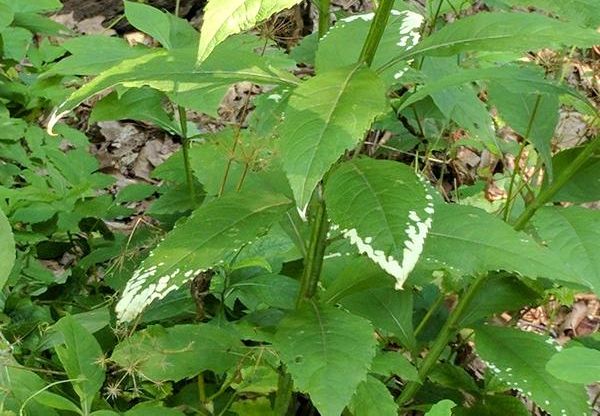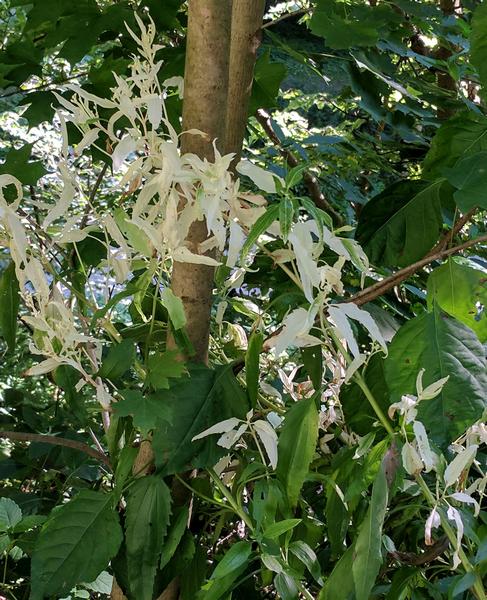
In July and August I noticed something I’d never seen before along the trails of western Pennsylvania — scattered instances of leaves turning white.
The leaves had been green but now their tips or even whole branches were white. The plant below had advanced to the stage where some of the stems were completely white.

The condition is called chlorosis and it means the plant is not producing enough chlorophyll to look green. Since chlorophyll uses sunlight to make food for the plant, it’s a sign the plant is in distress. But why?
Causes of chlorosis are wide-ranging. Here’s the list from Wikipedia, with my [notes] added:
- a specific mineral deficiency in the soil, such as iron, magnesium or zinc
- deficient nitrogen and/or proteins
- a soil pH at which minerals become unavailable for absorption by the roots
- poor drainage (waterlogged roots) [Not likely in this case.]
- damaged and/or compacted roots [Not likely in this case.]
- pesticides and particularly herbicides may cause chlorosis, both to target weeds and occasionally to the crop being treated. [Not likely in this case due to location.]
- exposure to sulphur dioxide [Possible in Pittsburgh but not likely in this case.]
- ozone injury to sensitive plants [Not likely in this case.]
- presence of any number of bacterial pathogens, for instance Pseudomonas syringae pv. tagetis that causes complete chlorosis on Asteraceae.
Interestingly, the plants I photographed are in the Aster Family (Asteraceae) and one of them has complete chlorosis.
Was the 2017 growing season especially bad for the bacteria mentioned above? Or does chlorosis happen every year and I’ve just not noticed?
If you know more about this condition in the wild, please leave a comment. I’m really curious!
(photos by Kate St. John)
I have never seen or heard of this. I will be very interested to see what others have to say about this condition.
My tree is white in my backyard what should i do
Find an arborist to diagnose the problem. (In Pittsburgh, I call Bartlett Tree Experts for my own trees)
I have this on my African Violet pot plant
I see it in iowa 2021 i personally think it is uv c rays bleaching kind of like what is happening to coaral reef
It is rare to see a wild plant with white leaves but good fun to ponder the mystery. One of the great thing about nature is that the “clues” are usually right in front of us if we are thoughtful and observant enough to identify them. Let’s look at your list:
1) Is it – a specific mineral deficiency in the soil, such as iron, magnesium or zinc
deficient nitrogen and/or proteins
– Likely, since it appears to start at the “tip” of leaves and work its way toward the base (see your picture).
– As you noted it is at the top of the plant, which is where much of the “new” growth occur.
– We know the plant should be green but while it isn’t dying… it is white. We know that chlorophyll is what makes them green.
– Because the “New” growth is what is affected, we can rule out magnesium, phosporus, potassium, and a bunch of others but that still leaves calcium, sodium, sulphur and others.
– Because the whole leaf tends to bleach out not through an interveinal process, we can rule out a bunch of the micronutrients deficiencies.
– Wouldn’t be nitrogen deficient because plants can move nitrogen around and that doesn’t appear to be happening here – note the older leaves are a nice healthy green color.
– One good suspect: Sodium can interfere with the utilization of potassium, calcium and magnesium. When sodium accumulates in leaves, it causes the tip of the leaves to die and a yellowing or whitening of a plant’s leaves and stems occurs due to a lack of chlorophyll particularly on new growth.
2) Is it: a soil pH at which minerals become unavailable for absorption by the roots
– This could be part of the problem, which may be how sodium or something became limited in the first place. But it may be part of the same problem as #1 above. It could just be the mechanism of “How” the nutrient became limited.
3) Poor drainage (waterlogged roots) [Not likely in this case.] Agreed.
4) Damaged and/or compacted roots [Not likely in this case.] Agreed.
5) Pesticides and particularly herbicides may cause chlorosis, both to target weeds and occasionally to the crop being treated. [Not likely in this case due to location.] Agreed.
6) Exposure to sulphur dioxide [Possible in Pittsburgh but not likely in this case.] Agreed.
7) Ozone injury to sensitive plants [Not likely in this case.] Agreed.
8) Presence of any number of bacterial pathogens, for instance Pseudomonas syringae pv. tagetis that causes complete chlorosis on Asteraceae.
a) Argument for this – it causes apical chlorosis.
b) Argument against – Your pictures do not show any stunting of growth or affected reproductive structures.
Agatha Christie anyone ?
all my potted plants on my deck are turning white and dying this has never happened before
Several years ago, we had a bush that had white all over it. It did not come off when touched. I just figured it was a fungus of some sort, but it may have been this issue. The area was overgrown with weeds, so we took care of those and cut the bush back to the ground. It grew back just fine, so maybe all those weeds had something to do with the soil condition.
We have a large hedge made up of a number of plants all are healthy a season ago a couple of small new growth stems had white leaves and stems I pruned it out leaving a few leaves not wanting to make a small hole in hedge however now less than a year with the new growth season it has spread over a square meter worried it will not only continue on this plant but continue to others inline this is first time post
It might be worth collecting a soil sample and having the local Agricultural Extension office test it, sometimes they do this for free.
The leaves are alive seem healthy but pure white
Bought malpighia c recently about a week ago and it was in the shade there. The nursery guy said I cd keep it in the sun but nowleaves turning white. Wonder if it has anything to do with the Indian June summer sun
Amulyajit Kaur, I’m sorry I don’t know the answer to your question as I am unfamiliar with your climate and Malpighia.
What do I do about leaves turning white in my recently planted garden.
I’d suggest consulting a local Master Gardener.
I’ve got a few plants in my yard turning white front & back yard I’m curious as to why they are turning, I havent been here but a year soooo….I’m not familiar with what grows here really
I found my first all white privet 4 months ago in red clay in west central Georgia it was about 4 inches tall. I could barely get it out of all the interlocking roots. I brought a pot with miracle gro with me. It has taken very well and is about one foot tall and absolutely beautiful. My favorite plant. I don’t understand how it survives without chlorophyll.
in my land there is fruiting jack tree.it’s fruit bearing part is normally green .other part of that tree leaves and stems are white. Reading after I also suggest insufficient of chlorophyll
My roses were infected with black spot ,sprayed them with Mancozeb after the second spay the young leaves turned white hopefully they’ll turn green.
I had a tropical hibiscus tree in my house over
the winter. When I took it outside the leaves turned white over night. It doesn’t look like
it’s dying , it’s just weird.
The exact same thing is happening to our hibiscus. We just brought it outside and most of the leaves are turning white. Other than that, it looks healthy. What did you do for yours? Did it survive?
We have this exact thing happening over a 20 acre area in eastern nc. Very wide ranging species. Grass, trees, vines. Noticed it some last year but to different plants. It is bizarre. The plants look healthy, just patches of no color, just like these pictures. Not yellow or sick looking just white. I am so curious to know what is happening. Have you found anything out?
Jenn, the phenomenon you describe is unknown to me but you describe it affecting so many unrelated things (grass, trees, vines) that it makes me wonder if a systemic poison fell in rain or arrived on the air.
My question is on the spine combreturm when it’s flowering the leaves near those flowers become white , what course those leaves to turn white and how does it happen
I think it’s topical-meaning chemicals in the air damaging certain plants. Possibly chemtrails.